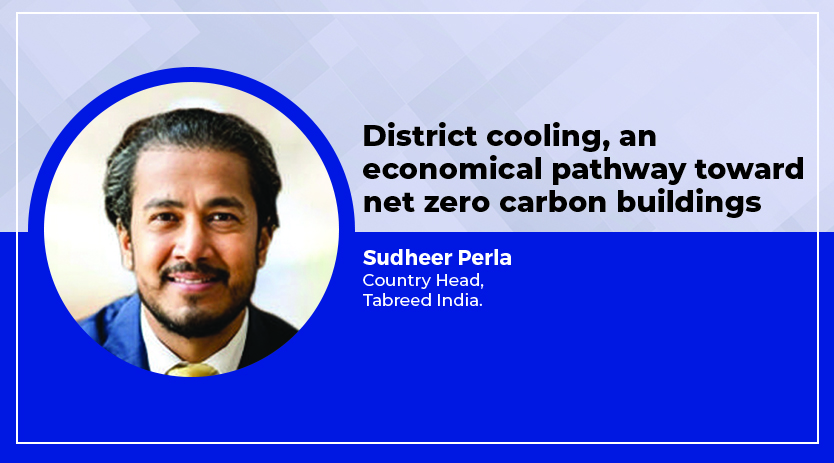According to Sudheer Perla, Country Head, Tabreed India, District cooling seamlessly fits into sustainable urban planning goals. The projected 11-fold surge in cooling needs by 2037-38 in expanding cities underscores the urgency for energy-efficient solutions.
Please provide an overview of Tabreed’s strategic initiatives as a cooling utility.
Tabreed, headquartered in the UAE, is the world’s largest publicly listed district cooling utility. It specialises in offering efficient, cost-effective, and eco-friendly cooling solutions yearly. With 87 operational plants, Tabreed supplies 1.35 million refrigeration tons (RT) of cooling services to a wide range of residential, commercial, governmental, and private developments in regulated and non-regulated markets the company operates in. This helps curb over 1.3 million tons of CO2 emissions annually, showcasing its commitment to sustainable cooling practices.
In India, Tabreed has established a strategic investment platform in collaboration with the International Finance Corporation (IFC), a part of the World Bank. This partnership aims to cater to approximately 100,000 refrigeration tonnes (RT) or 50 million square feet in the coming years. On the private real estate front, Tabreed has recently entered a groundbreaking agreement with Tata Realty, a prominent Indian developer. This unique concession involves delivering cooling as a service (CAAS) on a Design-Build-Finance-Own-Operate (DBFOO) basis for a Grade A commercial campus in Gurugram. This campus demands cooling loads of 6,600 RT. Tabreed has solid expertise in design, engineering, and development within India, and it is actively working to bolster local supply chains and operational capabilities. This initiative ensures the seamless implementation of global best practices in the country.
What is your outlook on implementing district cooling plans in India?
India is facing a crucial convergence of challenges: rapid urbanisation, extreme heat waves surpassing survivability limits, and a subsequent surge in cooling demand projected to account for 45% of the country’s peak electricity usage by 2050. District cooling and other innovative technologies are emerging as compelling solutions to these issues.
District cooling involves centralising chilled water production, which is then distributed through a network of pipes to provide cooling efficiently, significantly slashing electricity consumption and greenhouse gas emissions. A district cooling plant serving 1 million sq. mtrs., of air-conditioned space could lead to savings of up to USD 20 million in capital expenses, a yearly reduction of 0.02 to 0.04 million tonnes of CO2 emissions, and a decrease in energy demand by approximately 40 MW. District cooling can potentially align with India’s Nationally Determined Contributions (NDCs) and make cooling accessible to a broader population. This importance is emphasised in India’s 2019 Cooling Action Plan launched by the Ministry of Environment, Forest and Climate Change (MOEFCC) and the more recent District Cooling Guidelines introduced by the Bureau of Energy Efficiency (BEE). It underscores the importance of championing district cooling in India.
At the forefront of India’s nascent sustainable cooling sector, Tabreed’s objective is to promote energy-efficient cooling solutions. This involves offering an alternative to conventional air conditioning systems through District Cooling Systems (DCS), aligning with India’s energy and environmental objectives. Tabreed is pursuing a multifaceted strategy built on collaboration, partnerships, and innovative business models to achieve this.
At the forefront of India’s nascent sustainable cooling sector, Tabreed‘s objective is to promote energy-efficient cooling solutions in India by providing an alternative to conventional air conditioning systems in the form of DCS, aligning with the country’s energy and environmental goals. For this, Tabreed is pursuing a multifaceted strategy founded on collaboration, partnerships and innovative business models.
How does Tabreed’s strategy for CaaS contribute to scaling up the transition to a greener economy, particularly in the built environment of India?
District cooling, a well-established concept in developed markets spanning Europe, the US, the Middle East, and Asia, is gaining momentum through diverse models. Within fully funded concessions, known as cooling as a service (CaaS), a provider owns the cooling infrastructure and covers operational and utility expenses. Meanwhile, customers or end users pay based on the cooling units consumed in each billing cycle. This customer-centric and adaptable approach of CaaS lessens the upfront investment for customers in cooling systems and removes the burden of maintenance and operation. It also aligns the incentives of cooling providers with customers by ensuring efficient and reliable operations that extend the life of assets.
Integrating district cooling into project master plans aligns with the principles of a green economy, resulting in durable and efficient cooling systems that reduce energy consumption. Furthermore, integrating clean energy sources and sustainable practices, like repurposing greywater for heat dispersal, enhances the environmental footprint of buildings. This leads to additional points in green building ratings. Noteworthy advantages encompass a potential 40% reduction in installed cooling capacity, translating to diminished power demand on the grid. This could lead to up to 50% lower power requirements and zero coolant leakages, directly translating into reduced GHG emissions.
District cooling seamlessly fits into sustainable urban planning goals. The projected 11-fold surge in cooling needs by 2037-38 in expanding cities underscores the urgency for energy-efficient solutions. Tabreed effectively harmonises urban expansion with responsible energy practices and ecological preservation by accommodating this demand surge through district cooling. This proactive approach catalyses the transition to India’s greener and more sustainable built environment.
Could you discuss the aims and initiatives of Tabreed’s partnership with Tata Realty?
Tabreed’s collaboration with Tata Realty involves an investment of INR 100 crores to offer long-term cooling solutions for the Intellion Park development in Gurugram, India, within the Northern Capital Region. Intellion Park, distinguished as a Grade A office campus, sets a notable benchmark for sustainability and boasts LEED Platinum certification. The project incorporates multiple passive cooling design elements, including radiant cooling and a centralised cooling system driven by an optimised HVAC design.
This combined strategy has led to exceptional efficiency, where each cooling ton serves an impressive 700 sq. ft. of space, far surpassing the usual 300-400 sq. ft. per ton ratio. This results in a Building Energy Performance Indicator (EPI) of under 100 kWh per sqm, starkly contrasting the average EPI of 150-200 kWh per sqm seen in conventional green buildings. This partnership underlines Tata Realty’s forward-thinking approach to real estate, showcasing its commitment to spearheading sustainable innovation.
Marking the first 30-year cooling as a service (CaaS) concession in India, Tabreed will offer Key Performance Indicator (KPI)-linked Service Level Agreement (SLA) based cooling services that are more energy efficient and dependable. Additionally, Tabreed commits to expanding capacity to meet the future cooling service requirements of the Intellion Park development. This collaboration with Tata Realty is a pioneering effort for the cooling as a Service (CaaS) market in India, where the prevalent practice involves real estate developers investing capital in building their cooling assets and outsourcing operations through facility management contracts.
How will Tabreed impact the increase of greenfield expansion and cooling capacity in Tata Realty’s Intellion Park in Gurugram?
The expansion efforts at Intellion Park involve extending cooling services to the remaining four towers within the development area. This expansion aims to serve a combined load of 6,600 RT, building upon the existing operational two towers. Tabreed will conduct a comprehensive and detailed design process for the central HVAC system. This will be accompanied by a phased capacity deployment plan, ensuring that the cooling needs of the development are met efficiently.
Further, to achieve this, Tabreed will initiate a competitive procurement process, leveraging its in-house Supply Chain Management (SCM) capabilities. This process will also capitalise on the synergies and scale of procurement shared with the developer. Tabreed will manage contract execution, project management, and commissioning to ensure the cooling plant room becomes operational in line with the developer’s desired timelines.
Furthermore, as part of the ongoing expansion strategy, Tabreed is considering incorporating heating solutions for the winter months. This modification accommodates the night shift operations of multinational tenants within Tata Realty. Importantly, this heating integration will be achieved without incurring extra infrastructure or operational costs, leading to energy savings of up to 20% annually vis-à-vis boilers and duct heaters.
What are your views on the energy efficiency of district cooling compared to traditional air conditioning?
District cooling presents significant energy efficiency benefits compared to conventional air conditioning systems, potentially resulting in savings ranging from 20% to 50%. By aggregating demand and optimising load profiles, district cooling achieves maximum efficiency. Unlike standalone air conditioning units that often use substantial refrigerants and pose leakage risks, district cooling minimises its environmental footprint. It leverages natural water sources for heat dispersion, mitigating negative environmental impacts. Additionally, integrating technologies such as thermal energy storage, solar power, waste heat recovery, and treated sewage effluent further enhances its eco-friendliness, aligning with circular economy principles.
In India, where the built environment accounts for over 40% of global energy demand and contributes to 22% of greenhouse gas emissions, the advantages of district cooling hold immense significance. While ongoing decarbonisation efforts stem from regulations and market participants’ actions, these endeavours can be accelerated through innovative business models and energy-efficient technologies. Solutions like district cooling, delivered through a cooling-as-a-service (CAAS) model, can address the nation’s growing cooling needs, aligning with low-carbon pathways. District cooling can serve as a cost-effective, low-carbon pathway for entire cities to cater to their energy needs while expediting the transition to green and net zero-carbon buildings.
Cookie Consent
We use cookies to personalize your experience. By continuing to visit this website you agree to our Terms & Conditions, Privacy Policy and Cookie Policy.













